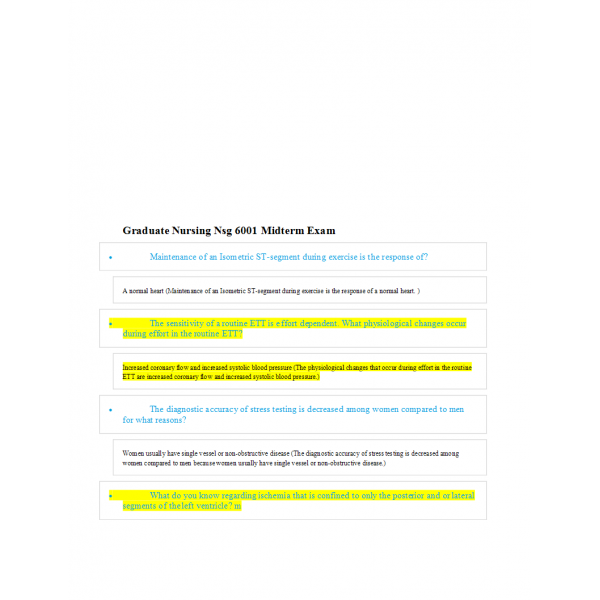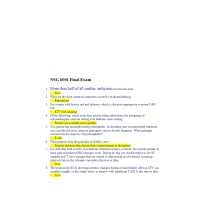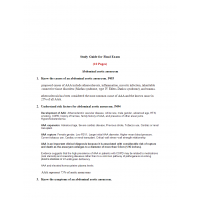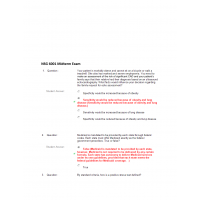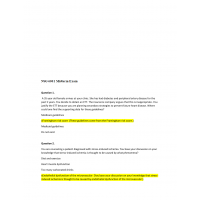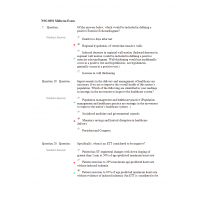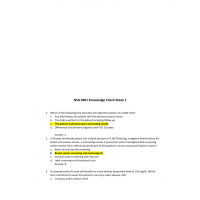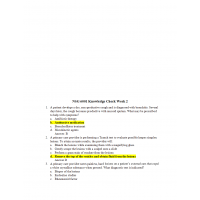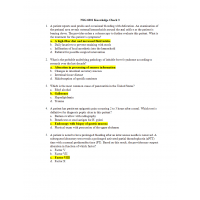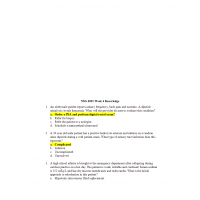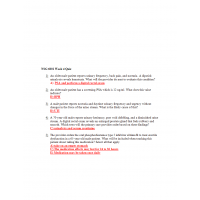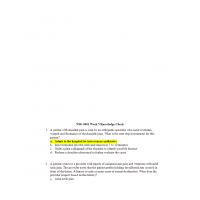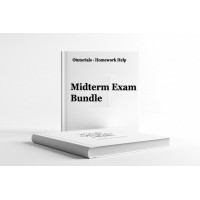NSG 6001 Midterm Exam Review
NSG 6001 Midterm Exam Review – Graduate Nursing South University
- Maintenance of an Isometric ST-segment during exercise is the response of?
- The sensitivity of a routine ETT is effort dependent. What physiological changes occur during effort in the routine ETT?
- The diagnostic accuracy of stress testing is ……among women compared to men for what reasons?
- What do you know regarding ischemia that is …..to only the posterior and or lateral segments of the left ventricle?
- Your preceptor decides to add Doppler Flow studies to the echocardiogram exercise test for a patient with a recent history of a holistic murmur best auscultated at the left steral boarder. The patient has no history of cardiac surgeries. He asks you what might be the main advantages of adding Doppler Flow for this particular patient. You know from your readings that there are several reasons to add Doppler Flow and below are listed more than one correct reason. Your best response for this specific case, however, would be that Doppler Flow studies would be of what additive value during the echocardiogram study?
- Your patient cannot sit on a bicycle and has difficulties walking a treadmill with limited capacity for exercising. Still, you know that the ETT is the preferred test for CAD. You consider adding a pharmacological agent to get to maximum heart rate. What agent would be the most commonly …..agent to assist in an ETT?
- Medicare covers inpatient hospital services under which part of the Medicare insurance?
- Medicare hospital insurance (Part A) is …..through what system?
- Your patient has a maximum age-predicted heart rate of 180. During the exercise he reaches a heart rate of 140 and then states he can no longer exercise. Nsg 6001 midterm exam You see evidence of ischemic changes on the ECG. This would be predictive of what condition?
- Your patient underwent an exercise stress test for CAD. There is significant elevation of the ST-segment. What do you need to know about these changes to manage your patient’s care?
- What purpose does the principle of fidelity serve in the provider/patient relationship?
- After completion of the exercise stress test, you would measure the ST-segment depression after the J point of the QRS. The J point is located where in relation to the QRS?
- What ECG changes can reduce the specificity of the ETT?
- You are counseling a patient ……with stress-induced ischemia. You base your discussion on your knowledge that stress-induced ischemia is thought to be caused by what phenomena?
- Medicaid is mandated to be provided by each state through federal codes. Nsg 6001 midterm exam Each state must offer Medicaid exactly as the federal government prescribes. True or false?
- You are considering adding an adjunctive form of testing to detect wall motion abnormalities during the ETT. You-select Echocardiography as the added testing. You choose this test because you know that echocardiography does what when added to a standard ETT?
- The leads on the ECG showing ischemic changes during or immediately after an ETT can correlate roughly to the culprit artery or arteries with significant CAD. Is this true or false?
- Of the answers below, which would be included in defining a positive Exercise Echocardiogram?
- Why would inability to exercise reduce the specificity of the routine ETT?
- In CAD, after both systolic and diastolic dysfunction have occurred, the typical pattern of chest pain and related EKG changes occur. During an EKG, you should expect to see ST-segment and T-wave changes that are central to demonstration of ischemia occurring relatively late in the ischemic cascade. Is this true or false?
- What happens to coronary flow related to CAD?
- Chronic, non-communicable diseases account for disproportionate costs to the healthcare system. According to the World Health Organization, what percent of preventable deaths and disabilities occur in the Americas related to chronic non-communicable diseases?
- What is ……the first-line initial approach to test for CAD?
- You are in the clinic with your mentor observing the Echocardiogram exercise test of a 45-year old male that has been experiencing slight chest pressure almost daily during exercise. Nsg 6001 midterm exam While observing your patient, your mentor points out that the left ventricle wall is thinning and there is some hyperkinesias of the ventricular wall. From your time in the clinic, you know that this test will be …..to be what type of result?
- What three conditions definitely alter the results of echocardiography in determining CAD?
- For women with known CAD and diabetes, which is most appropriate to assess CAD risk?
- Ischemic changes on ECG during ETT is highly predictive of CAD. Nsg 6001 midterm exam What is another important strong predictor of CAD that you might see during an ETT?
- A 35 year old female arrives at your clinic. She has had diabetes and peripheral artery disease for the past 5 years. You decide to obtain an ETT. The insurance company argues that this is inappropriate. You justify the ETT because you are planning secondary strategies to prevent future heart disease. Where could one find the supporting data for these guidelines?
- Your mentor says that you should be …..to know how to determine the maximum heart rate for your patient during the ETT. How is the age-predicted maximum heart rate during an ETT determined?
- Population disease management is a term used to describe:
| Institution & Term/Date | |
| Term/Date | South University |
-
$25.00

